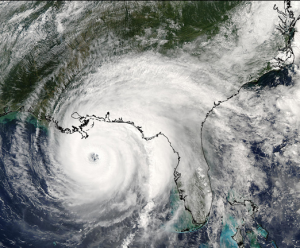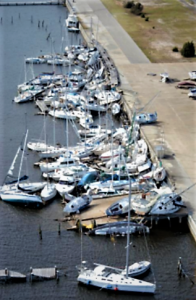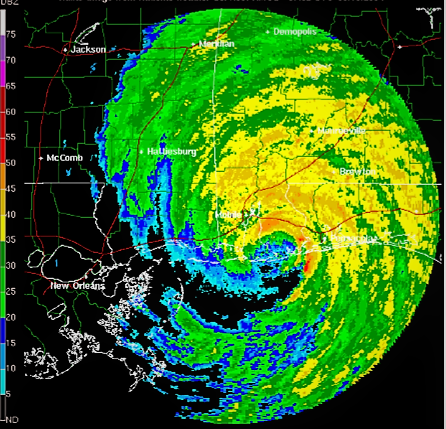
Among the various weather events which challenge Escambia County, hurricanes established the strongest impact. On September 16, 2004, Hurricane Ivan made landfall near Mobile Bay, Alabama and became the most destructive hurricane to inundate Escambia County in over 100 years. The tropical system set 18 weather records along its path including strongest hurricane southeast of the Lesser Antilles, southernmost major hurricane on record, and most consecutive hours maintaining a Category 5 status on the Saffir-Simpson Scale. The massive hurricane producing peak winds measuring 145 mph and 943 millibars intensity.

Prior to landfall, Hurricane Ivan amassed a documented 52.5-foot wave while 70 miles south of Mobile Bay, Alabama, and spawned 117 tornadoes, including 18 tornadoes in Florida. Seven oil platforms reported severe damage in the Gulf of Mexico as Hurricane Ivan battered the structures. Wind speed at the time of landfall measured 105 knots, and the eye diameter stretched 40-50 nautical miles which brought the strongest winds of this event to the boarder of Alabama and Florida, at Perdido Bay. Impact from Hurricane Ivan became widespread and included 9 states. Ninety-two individuals lost their life as a direct result of Hurricane Ivan, including 14 in Florida.
Damage reports from Hurricane Ivan highlighted its impact on the Florida Panhandle. Thousands of homes and structures reported damage or destruction in Escambia, Santa Rosa, and Baldwin Counties. The neighborhood surrounding Ariola Drive, on Pensacola Beach, reported severe damage. Newspaper reports, however, praised construction of the Dome Home by designer Mark Sigler who built a home on Ariola Drive in the shape of a dome which could withstand 300 mph wind. Stairs attacked to the home broke away, as designed, however the structure remained intact, regardless of mass destruction within the neighborhood.

Millions of acres of forests and woodlands became destroyed including the destruction of Pine Pulpwood, Hardwood Pulpwood, Pine Saw-timber, and Hardwood Saw-timber. A storm surge of 10-15 feet and accompanying wave action resulted in severe damage to Interstate 10. A portion of the Thomas A. Johnson Bridge, reported severe structural damage forcing authorities to sink the remaining portion of this historic bridge which stood over Pensacola Bay since 1931. Parts of Highway 90 washed out from Hurricane Ivan impacts, and Perdido Key became elevated. WEAR TV reporting out of Pensacola measured 15.75 inches of rain, and Pensacola NAS reported nearly 1 billion dollars in damage. Authorities calculated the total U.S. damage from Hurricane Ivan as 18 billion dollars.
Recommended Readings
Stewart, Stacy R. “Tropical Cyclone Report: Hurricane Ivan.” December 16, 2004. National Hurricane Center. NOAA. Department of Commerce. Accessed April 2, 2017. http://www.nhc.noaa.gov/data/tcr/AL092004_Ivan.pdf
Office of Coastal Management. “Historical Hurricane Tracks.” National Ocean Service. NOAA. Department of Commerce. Accessed March 1, 2017. http://coast.noaa.gov/hurricanes/index.html
Featured Image:
Weather Forecast Office. “Powerful Hurricane Ivan Slams the Central Gulf Coast as a Category 3 Hurricane.” September 16, 2004. Image. National Weather Service. NOAA. Department of Commerce. Accessed April 18, 2017. http://www.weather.gov/mob/ivan
Author: Diana Ritzie
ORCID ID: 0000-0001-6678-3157

